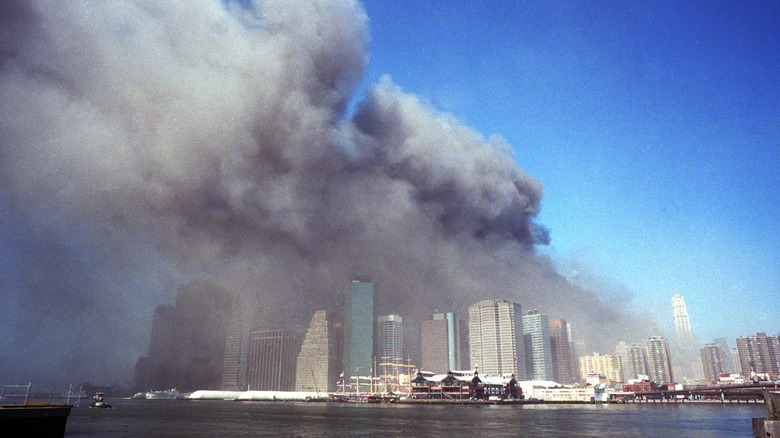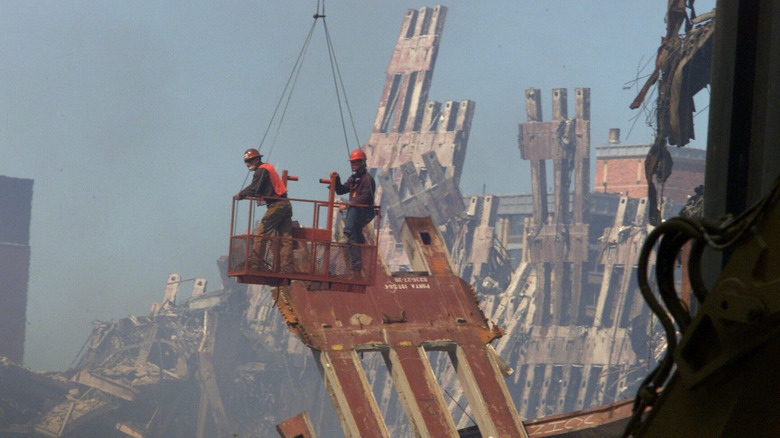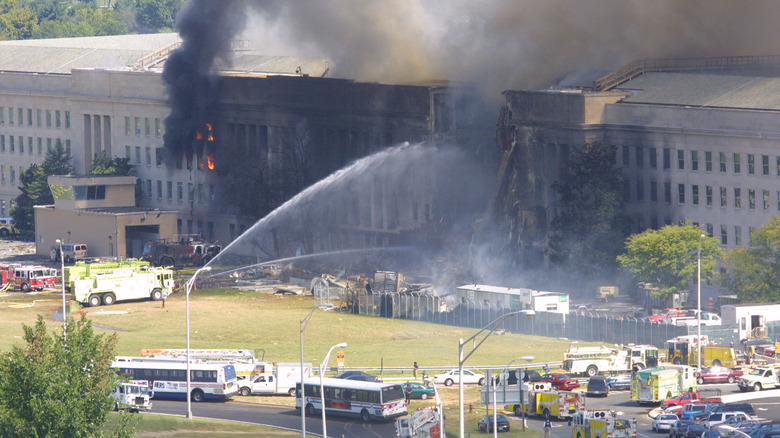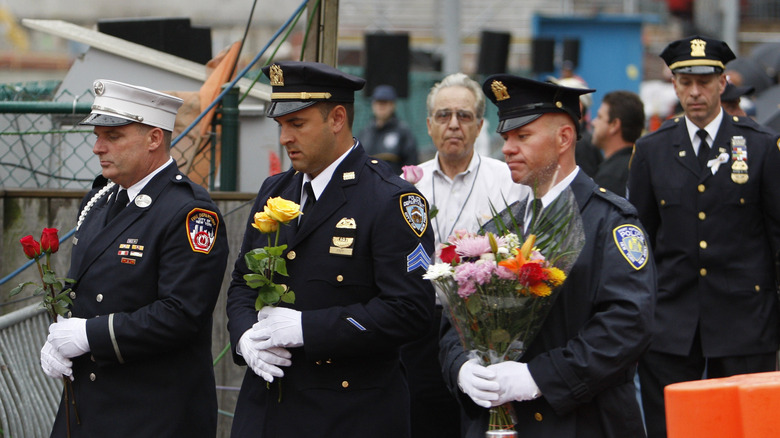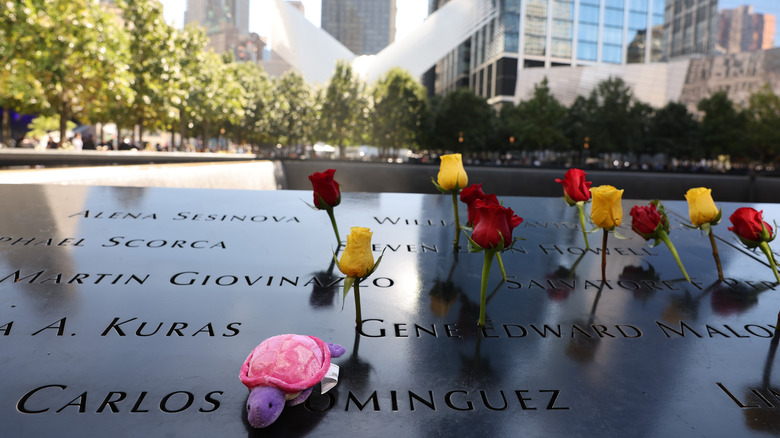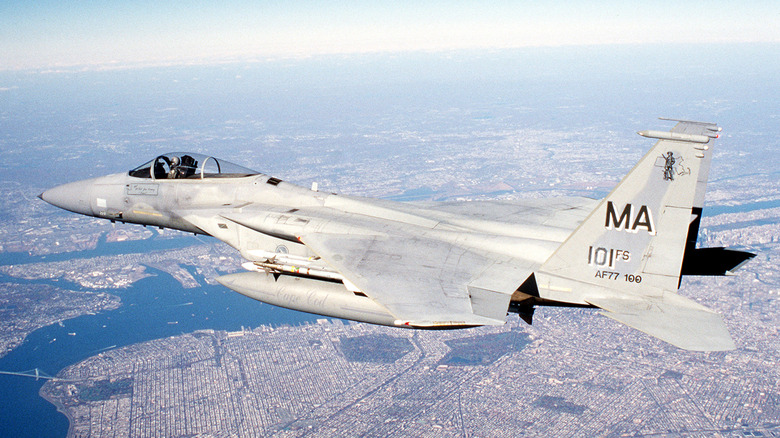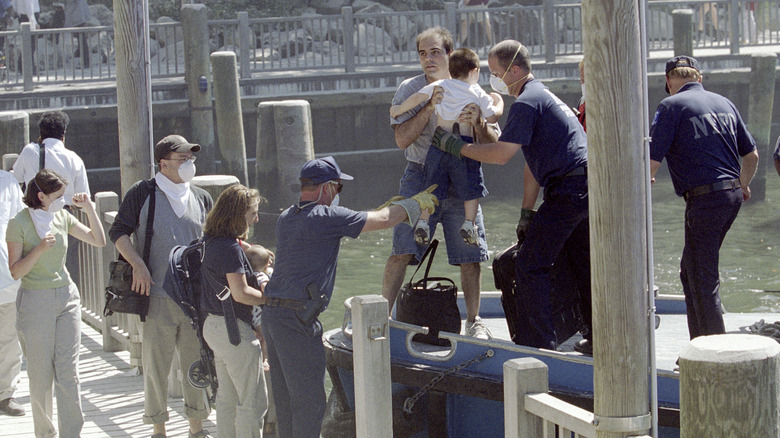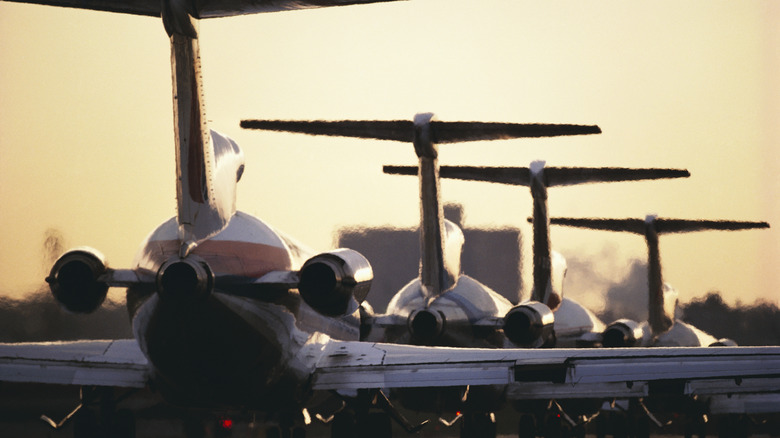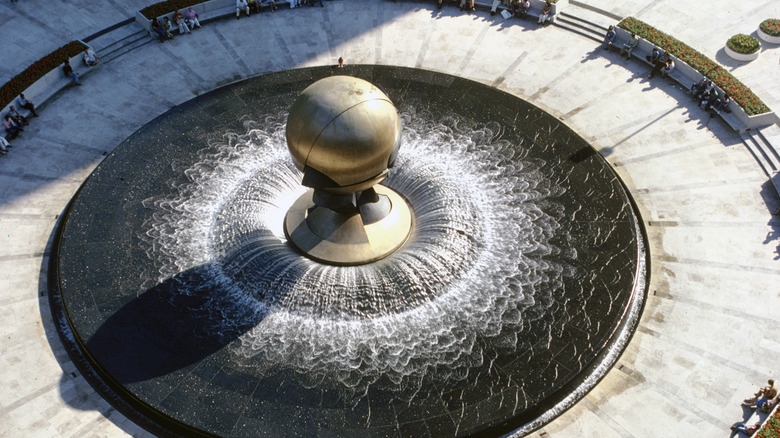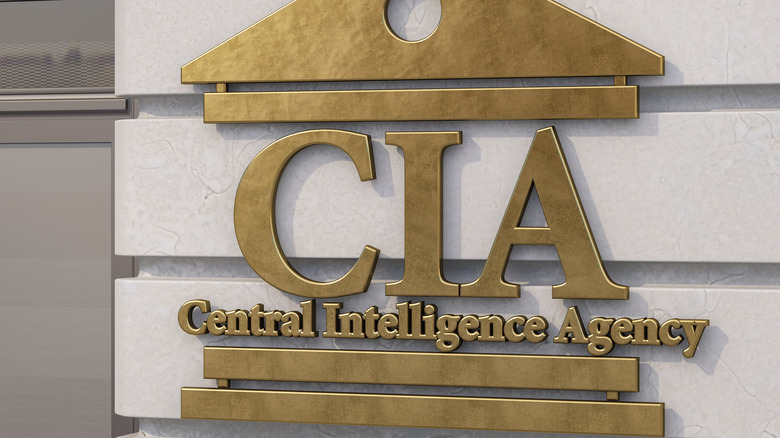Unusual 9/11 Stories History Overlooked
The images of the terror attacks that struck the United States on September, 11, 2001, have remained seared in the consciousness of the Western world. Indeed, the assaults continue to be among the most shocking events of the 21st century. Those over a certain age will forever remember the moment when the second plane hit the World Trade Center in New York and the globe knew for certain the United States was under attack.
The tragedy killed nearly 3,000 people with two strikes on the Two Towers of the WTC and one on the Pentagon. Another failed attack — the target of which isn't known for sure — resulted in the plane crashing into a field in Somerset County, Pennsylvania. The incidents have been pored over continuously by government agencies, the media, and everyday people looking to discover how such an atrocity could happen in the modern world. The result was that the world changed: Increased security in everyday life at home and a wide-ranging War on Terror overseas as the U.S. and its allies sought to bring to justice the al-Qaida terror cells responsible for the attack, as well as other potential attackers across the globe.
But while the major details of 9/11 are common knowledge to most people today, such a multi-faceted world event generated countless stories that are not as well known. From unseen diseases to chaos at the top levels of government, plenty of tales got lost amid the chaos. Here are some of the 9/11 stories history overlooked that you may not know, but certainly should.
The scale of the WTC clean-up was immense
The strikes against the World Trade Center towers catastrophically damaged the structure of both buildings, causing them to collapse shortly after being hit. The result was 1.8 million tons of wreckage pouring into the streets of New York, within them the remains of thousands of people who were still trapped inside the buildings when they fell. The horrific task facing first responders looking for survivors in the wreckage is well documented. Despite thousands helping, only 21 people were rescued from the rubble, all within the first day of the attack. After that, the responders faced the grim task of identifying human remains among the wreckage and clearing the streets of what was once the tallest pair of buildings in the world.
The clearing of the wreckage was orchestrated so that the rubble was transported to the Fresh Kills landfill site on Staten Island, where fragments were inspected for traces of human remains. It took a total of eight months to clear the streets of New York City of what was left of the Twin Towers, a task that cost $600 million. But to say that there was a full cleanup after attacks on the World Trade Center would be to overlook the immense long-tail impact of the dust and detritus on the health of those present. To this day, countless people have died from or continue to live with deleterious health conditions as a result of the dust (which contained concrete, asbestos, and other carcinogens) that they were forced to breathe during those months of clearance.
Footage of the Pentagon attack wasn't officially made public for years
The September 11 terrorist attacks were especially notable in media terms, as they were some of the most prominent major news events to first be broadcast on rolling news. Coverage was uninterrupted for four days after the attack, with its images seared into the world's collective consciousness. But while footage of the planes striking the Twin Towers was replayed time and time again, the attacks against the Pentagon and the crashing of Flight 93 were covered using shots of the damage to the Pentagon and the flight wreckage, taken after the event. That Flight 93 came down in a remote rural area meant that no footage exists of the moment of the crash. However, in the case of the Pentagon attack, footage did exist — security cameras captured American Airlines Flight 77's low-altitude collision with the southwest wall of the complex.
The impact killed a total of 184 people, including 59 onboard and 125 who were inside the Pentagon at the time. However, despite the scale of the atrocity, it took until May 2006 for the footage to be officially released to the media for broadcast, thanks to a Freedom of Information Act (FOIA) request deeming the footage to be in the public interest. Until then, it had only circulated via internet leak.
The NYPD and NYFD lacked coordination
The incredible bravery and selflessness of the first responders and emergency workers at the World Trade Center on September 11, 2001, has become the stuff of legend. Countless news stories, books, and documentaries have examined the experiences of those on the ground that day and the tales of people who tragically died. But thanks to the testimony of many of those on the ground at the time, it has also become clear in retrospect that the response to the attacks was somewhat mismanaged from an organizational point of view.
In 2004, a draft report from the commission investigating the events of 9/11 confirmed the shocking truth: Though the emergency services gave everything to respond to the terror attacks as they unfolded, they were hampered by a disturbing lack of coordination between departments. For instance, warnings received by police officers that the north tower was about to collapse were not relayed to firefighters at the scene, meaning they were unable to get to safety in time.
As early as 1996, government officials identified necessary improvements to New York City's emergency response infrastructure, and in the years preceding 9/11, emergency services did conduct drills and tabletop exercises to try to improve preparedness. However, communication in general was found to have been fatally poor. This was also due to the sad irony that the New York City Office of Emergency Management (OEM), which was responsible for emergency response coordination, was located in the World Trade Center and lost in the attack.
Advances in technology are still allowing remains to be newly identified
The carnage left at the site of the collapsed Twin Towers meant that identification of the victims was close to impossible. The incredible heat of the explosions and the force of the falling towers left few remains intact. While 293 bodies were recovered from the rubble, thousands of other victims were recovered in the form of 21,900 body fragments, extracted directly from the rubble or else found at the "Fresh Kills" landfill site where the wreckage was taken.
Identification of many of those lost in the attacks at first seemed impossible. But in the quarter of a century since 9/11, technology has advanced to such a degree that victims' remains continue to surface. In August 2025, it was widely reported that three more victims who lost their lives at the World Trade Center had been formally identified thanks to DNA technology.
"We had forensic experts telling us two decades ago, 'Really, you should not expect any DNA because of the physical act of the explosion itself, because of the heat,'" said Paul Keating, whose mother, Barbara, has finally been identified (per The New York Times). He also explained how the ongoing efforts to identify victims have moved him. "We're talking about people putting in overtime 24 years later, for us," he told the outlet. "That's the amazing, amazing part. You know they're not going to stop until they've identified every person."
The U.S. Air Force was considering kamikaze tactics
Once the second plane hit the World Trade Center on September 11, 2001, and it was obvious that the United States was under attack, every commercial jet still in the air was suddenly another strike waiting to happen. In response, the U.S. Air Force scrambled to launch as many fighter jets as humanly possible. The goal was to bring down suspicious aircraft before they reached their intended targets and minimize loss of life and potential damage to national security.
But not all those fighters that left their airbases were entirely equipped to deal with a hijacked plane. As former Air Force Lt. Heather Penney has recalled, she and her colleague, pilot Marc Sasseville, were ordered into the air despite their jets not being armed with missiles. This meant that were they to be given the order to take down a passenger plane, they would have to ram it with their jet, essentially making it a suicide mission they would not return from. It was a fate Penney, who was thankfully not given such an order, was nevertheless willing to accept.
"I had raised my hand and swore an oath to protect and defend our nation," she told ABC News. "If this was where the universe had placed me at this moment in time ... that this was my purpose. Anyone who had been in our position would have been willing to do the same thing. And the proof is in the pudding, because the passengers on Flight 93 did."
The 9/11 boat lift
The attacks on the World Trade Center occurred in one of the world's most populous cities. This, of course, meant that millions of people were in danger of the fallout of the strikes. Either from the rubble of the collapsing structures or other buildings (such as the 47-story WTC7, which collapsed due to fire) or from further potential attacks on the city.
As the danger became clear, the race was on to evacuate as many people as possible from Lower Manhattan. What occurred has been described as a miracle — the egressing of hundreds of thousands of people from the danger zone. The operation was on a scale even greater than that of the Battle of Dunkirk, when British troops and their allies escaped from the advancing Nazi forces across the English Channel on countless small boats.
The 9/11 escape also took place in boats. Since Manhattan is an island with a working waterfront, it was suddenly the job of mariners to escort citizens to safety across the water, which they did on a remarkable scale. According to the Coast Guard, some 750,000 people escaped Manhattan by boat that day in what has since been named the "9/11 boat lift."
The retired fireboat that returned to service
As the reality of the 9/11 attacks on the World Trade Center became clear, it was a case of all hands on deck to assure the safety of as many people as possible. And, just like Dunkirk, every small boat in the vicinity suddenly became a potential asset in the ongoing battle to save lives. Some of those vessels that became crucial to evacuation efforts weren't even in service at the time of the attacks. The John J. Harvey is one example — a historic ex-FDNY fireboat that was first used by New York City firefighters as early as 1931. Named after an FDNY fireboat captain who lost his life battling a ship fire the previous year, the 130-foot John J. Harvey was for decades the pride of the department, capable of pumping 18,000 gallons of water a minute through its water cannons.
By 2001, however, it had been retired from service for seven years. When the attacks happened, it was suddenly pulled back into action by a crew including the preservationists who had saved it from the scrapyard in 1999. The boat delivered around 150 people to safety, and at the direction of the FDNY, it was used to pump water from the river to nearby fire trucks.
The vaults of the WTC had to be cleared
It wasn't just people that urgently needed to be rescued from the collapsed towers of Manhattan's World Trade Center. As was widely reported in the months after the towers fell, the WTC was also home to a labyrinth of underground vaults that held millions in treasure. Authorities were concerned it may have been a target for looting even as recovery efforts were taking place on the devastated surface of Ground Zero. The 4 World Trade Center building was particularly noteworthy. Containing assets belonging to the Bank of Nova Scotia, the vaults contained 379,036 ounces of gold and 29,942,619 ounces of silver, which the bank reportedly valued at around $200 million.
Scorch marks on the security door leading to the vault raised fears that looters had already attempted to steal the bullion. By November, operations were underway to extract the gold and silver, while a host of other treasures — including weaponry, armored cars, files belonging to the Central Intelligence Service, and contraband and evidence seized by the Bureau of Alcohol, Tobacco and Firearms — were also identified under the rubble. With the help of armed agents, thirty firefighters were charged with extracting the bullion, which was safely relocated.
Flights were only allowed to take off in special circumstances immediately after 9/11
Once it became clear that a coordinated hijacking of commercial aircraft had taken place, all non-military planes were ordered to be grounded. Officials were concerned that planes of any size could be used by terrorists — some of whom may have trained in the United States — for further attacks. The airspace over the United States was cleared as early as 10 a.m. and remained closed for days after. As the Aircraft Owners and Pilots Association put it, it was "the day aviation stood still."
Reports claim that only a handful of civilian planes were given clearance to take to the skies after 9/11, and one of these was carrying very important cargo indeed. Lawrence Van Sertima was a Florida snake handler who was bitten by a venomous taipan snake. The bite would have been fatal without the administration of antivenom, and with his life in danger, the Federal Aviation Administration (FAA) allowed a plane to take off from San Diego, California, with the required medicine. The flight departed on September 12 — just one of at least four civilian planes to receive clearance — and was reportedly accompanied by two military jets. Thankfully, the antivenom arrived in time to save Van Sertima's life.
A fortune in art was lost
The cultural impact of 9/11 was immense, with the Western world suddenly veering from the optimism of the new millennium to a landscape defined by paranoia and suspicion. But the World Trade Center itself was also home to a great many important artworks, almost all of which were lost when the Twin Towers fell. The structure contained many sumptuous lobbies and offices — some of which belonged to companies attached to the art world — as well as a number of artist studios.
It was home to works by such feted artists as Joan Miro, Al Held, Roy Lichtenstein, and Elyn Zimmerman and was the workplace of artists such as Michael Richards, who tragically died in the attack. There were seven specially commissioned public artworks in the grounds of the World Trade Center, including "Cloud Fortress," Masayuki Nagare's work that graced Austin J. Tobin Plaza before the attacks. Along with paintings and sculptures, a whole galaxy of cultural artifacts were destroyed, including tens of thousands of original historic photographs and valuable craftworks, such as antique rugs worth hundreds of thousands of dollars. Some sources claim that 1,113 artworks were lost in the 9/11 attacks, of a combined value of more than $100 million. "The Sphere," a 25-foot bronze by German sculptor Fritz Koenig, which stood at the foot of the WTC, was later recovered. Though it was badly damaged, it now stands as part of the Ground Zero memorial.
There were forewarnings that an attack was imminent
It soon became apparent that prior to 9/11, intel suggested that a terror attack involving commercial planes was possible. In 2002, outlets reported that an FBI agent in Phoenix, Arizona, had received a warning two months before the attacks that numerous Arabic men had enrolled at American flying schools, while warnings from Filipino intelligence had been received as early as 1995. "FBIHQ should discuss this matter with other elements of the US intelligence community and task the community for any information that supports Phoenix's suspicions," the agent suggested in a memo, according to The Guardian. Suspicions remained high, but there was only one arrest the month after the memo was received. When the attacks took place, the FBI was in the process of planning security checks on flight schools.
But there was even more direct information about the attackers who perpetrated the 9/11 attacks circulating at the highest level. On August 6, 2001, President George W. Bush received a Presidential Daily Brief that outlined how Osama Bin Laden, the leader of terror group Al Qaeda, was "determined" to strike the United States, echoing warnings that the CIA had voiced to the White House as early as spring that year. Former CIA counterterrorism chiefs have since claimed that their warnings went unheeded.
